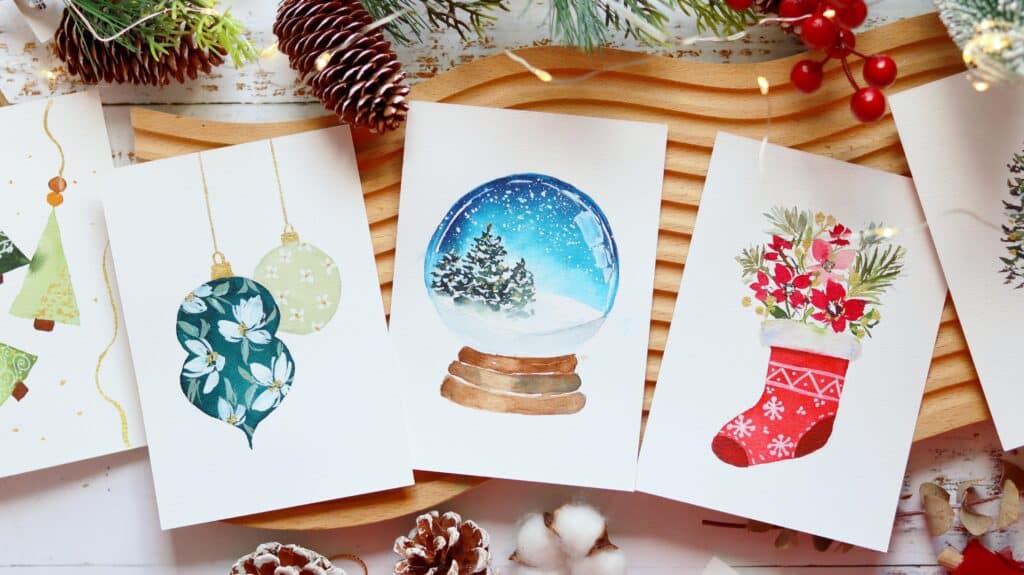
Watercolor Christmas drawings bring a gentle, handmade quality to your holiday celebrations that printed decorations simply can’t match. The soft blends of color and organic brushstrokes create festive artwork perfect for greeting cards, gift tags, wall art, and personalized decorations.
You can start creating beautiful watercolor Christmas art with just basic supplies like watercolor paints, brushes, paper, and water, making it an accessible craft for beginners and experienced artists alike. The forgiving nature of watercolor makes it ideal for holiday themes, where loose snowflakes, glowing candles, and simple wreaths look charming even with imperfect technique.
This guide walks you through everything you need to know about watercolor Christmas drawings, from gathering your materials to mastering simple techniques that produce stunning results. You’ll discover popular design ideas, practical tips for improving your work, and creative ways to use your finished pieces throughout the season.
Key Takeaways
- Watercolor Christmas drawings require only basic art supplies and work well for beginners learning simple techniques
- Popular subjects include Christmas trees, wreaths, ornaments, snowflakes, and holiday botanicals that suit various skill levels
- Your finished watercolor artwork can be used for handmade cards, gift tags, wall decorations, and personalized holiday presents
Essential Supplies for Watercolor Christmas Drawings
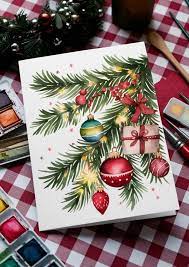
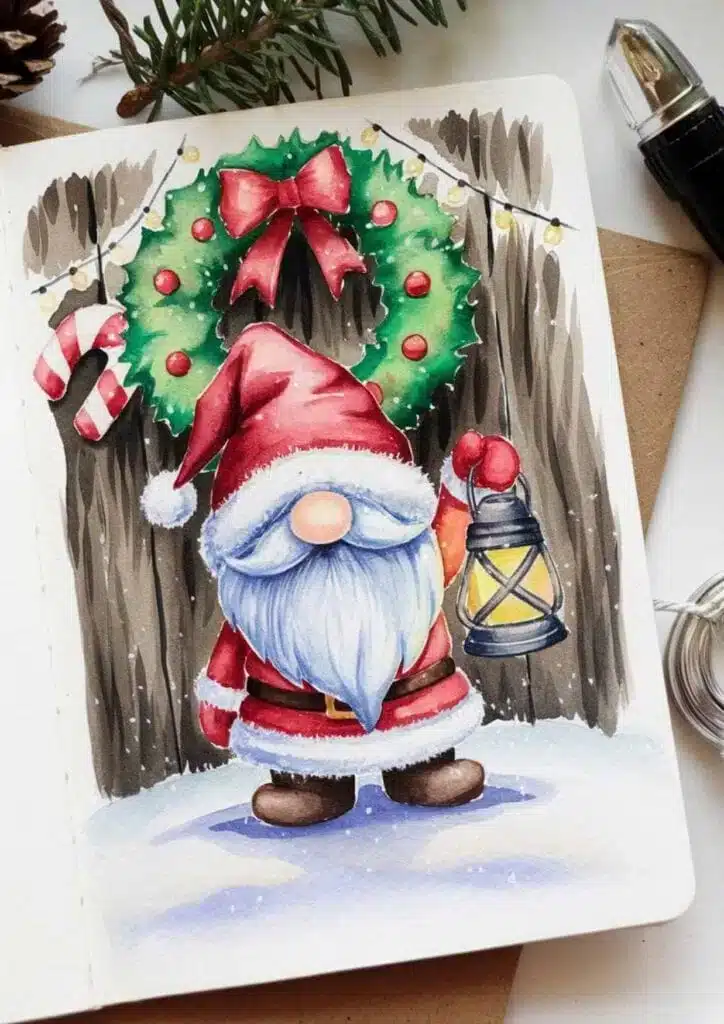

Quality materials make a noticeable difference in your watercolor Christmas artwork. The right combination of paints, brushes, paper, and erasers will help you create festive scenes with better color blending and cleaner details.
Must-Have Watercolors and Paintbrushes
Your watercolor paint selection should include both warm and cool tones essential for Christmas themes. Look for these key colors:
- Reds: Alizarin crimson and cadmium red for ornaments and Santa suits
- Greens: Sap green and viridian for wreaths and evergreen trees
- Blues: Ultramarine and Prussian blue for winter skies and shadows
- Specialty colors: Burnt sienna, yellow ochre, and white gouache for highlights
You can start with student-grade watercolors if you’re new to the medium, but artist-grade paints offer better pigmentation and mixing capabilities.
For paintbrushes, invest in a few quality rounds in different sizes. A size 6 or 8 round brush works well for medium areas like tree shapes and ornaments. A smaller size 2 or 4 round helps with fine details such as pine needles and snowflake patterns. Add a flat brush (half-inch or one-inch) for painting backgrounds and washes.
Synthetic brushes work perfectly fine for beginners and cost less than natural hair options. Make sure your watercolor brushes hold their point well and spring back to shape after each stroke.
Choosing the Best Watercolor Paper

Watercolor paper quality directly affects how your paint behaves and how your finished drawing looks. The paper must be thick enough to handle water without warping or buckling.
Choose paper that’s at least 140 lb (300 gsm) weight. This thickness prevents excessive warping and allows you to layer colors without the paper deteriorating. Cold-pressed watercolor paper has a slight texture that works beautifully for Christmas scenes, giving tree branches and snow a natural appearance.
Hot-pressed paper has a smooth surface better suited for detailed work with minimal texture. Rough paper provides the most texture but can be challenging for beginners. Cotton-based watercolor paper absorbs water more evenly than wood pulp paper and allows for better color lifting and correction.
You can buy watercolor paper in pads, blocks, or individual sheets. Blocks come glued on all sides, which keeps the paper flat while you work.
Selecting and Using a Kneaded Eraser
A kneaded eraser is essential for preparing your Christmas drawing before painting. Unlike regular erasers, this moldable tool lifts graphite without damaging your watercolor paper’s surface.
Before you start painting, use your kneaded eraser to lighten your pencil sketch. Press it gently onto the lines rather than rubbing. This technique leaves just enough graphite to guide your painting without showing through light washes. You can shape the kneaded eraser into a point for erasing small areas or flatten it to cover larger sections.
The eraser stays pliable and reusable for months if you knead it regularly to redistribute the absorbed graphite. Keep it clean by stretching and folding it between uses. Store it in its container or a small plastic bag to prevent it from drying out or collecting dust.
Popular Watercolor Christmas Drawing Ideas
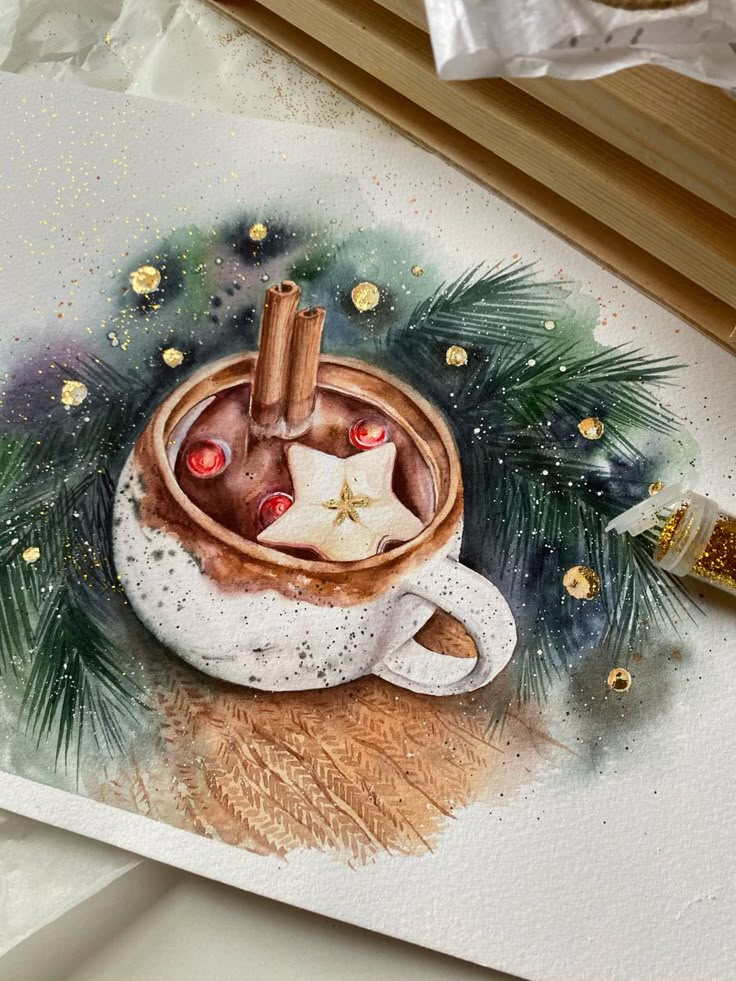
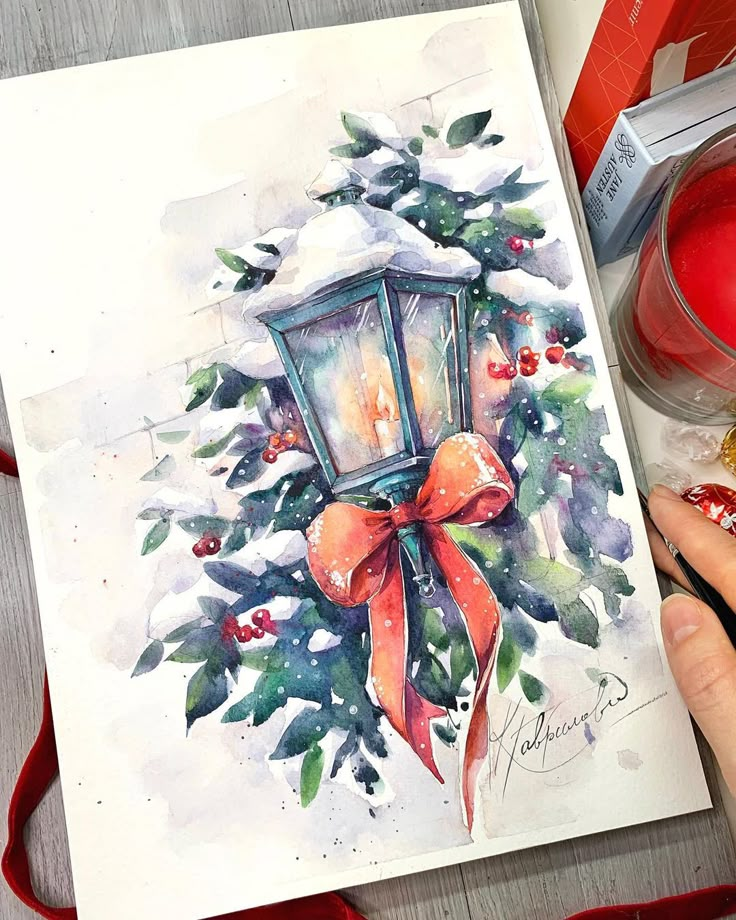
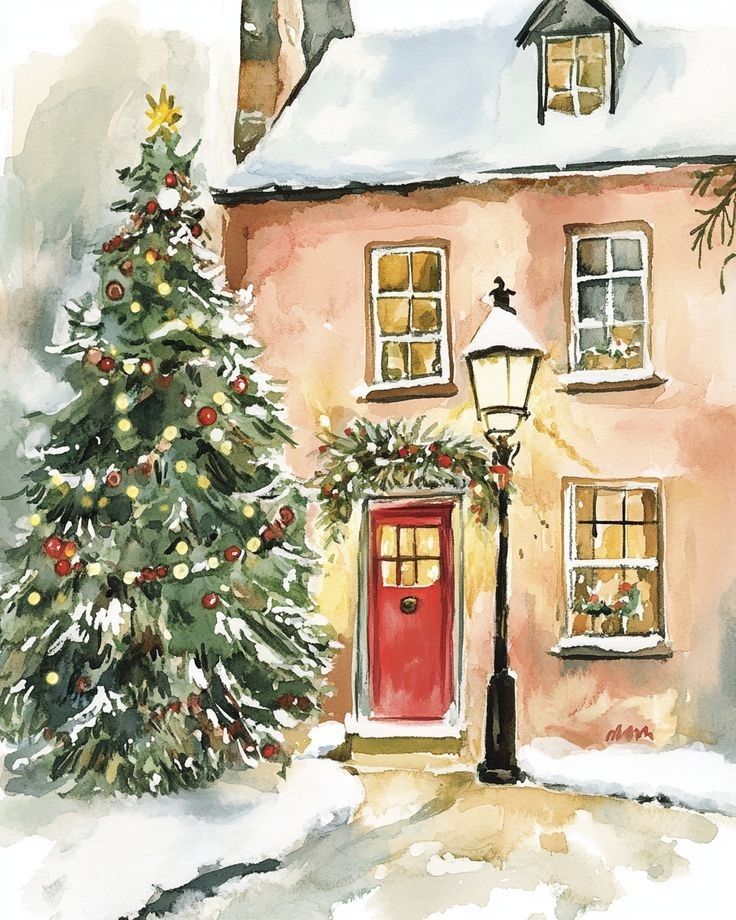
Watercolor techniques bring softness and warmth to holiday imagery, from traditional evergreens adorned with ornaments to whimsical characters and snowy landscapes. The medium’s natural blending capabilities make it ideal for capturing the cozy, nostalgic feeling of Christmas.
Classic Christmas Trees and Wreaths
Christmas trees are among the most approachable subjects for watercolor artists at any skill level. You can paint them in various styles, from geometric triangular shapes with simple ornament dots to detailed renderings with individual branches and needles. The wet-on-wet technique works beautifully for creating soft, blended green tones that suggest depth and dimension.
Wreaths offer circular compositions that look striking on cards and gift tags. You can build them with loose brushstrokes suggesting pine branches, then add berries, pinecones, and ribbon accents once the base layer dries. Try painting wreaths with different color palettes—traditional greens with red berries, or modern blues and silvers for a contemporary look.
Both subjects benefit from layering techniques. Start with light washes for the base, then add darker values to create shadow and texture. Small white highlights using gouache or leaving strategic white spaces can suggest snow or twinkling lights.
Festive Holly and Holiday Botanicals
Holly branches with their distinctive spiky leaves and bright red berries make excellent watercolor subjects. The contrast between the dark green foliage and vibrant berries creates natural focal points in your compositions. Paint the leaves with deliberate brushstrokes to capture their pointed edges, then add berries in clusters of varying sizes.
Other holiday botanicals include poinsettias, mistletoe, and evergreen sprigs. Poinsettias work well when you paint the large petals wet-on-wet, allowing reds to blend naturally. Mistletoe’s simple leaf shapes and small white berries create delicate accents perfect for card borders.
You can arrange botanical elements in garlands, scattered patterns, or elegant sprays. These subjects are forgiving for beginners since loose, organic shapes feel natural and artistic rather than imperfect.
Reindeer, Santa, and Other Christmas Characters
Reindeer translate beautifully into watercolor with their gentle features and distinctive antlers. You can paint them realistically or in simplified, whimsical styles with round bodies and oversized eyes. The key is building up layers for the brown fur tones while keeping highlights for dimension.
Santa works well in both detailed portraits and simple silhouette forms. Focus on his iconic red suit using rich, layered washes, and don’t forget the white trim which you can preserve by painting around it or adding with white gouache. His rosy cheeks benefit from soft pink washes that blend naturally.
Snowmen, elves, and penguins in winter scarves also make charming subjects. These characters allow for creative expression and work particularly well when you’re painting cards or decorations for children.
Charming Winter Scenes and Landscapes
Winter scenes capture the quiet beauty of the season through snowy cottages, bare trees, and soft skies. You can create atmospheric backgrounds using wet-on-wet techniques with blues and purples, suggesting twilight or overcast days. Simple cottage shapes with glowing yellow windows convey warmth against cool backgrounds.
Snowy landscapes need careful planning for white areas—you’ll want to preserve white paper for snow rather than trying to paint it. Add shadows under snow mounds using pale blue or violet washes to create depth. Bare tree branches painted in dark browns or blacks provide striking contrast against white expanses.
You can populate winter scenes with small details like smoke curling from chimneys, footprints in snow, or distant pine forests. These elements don’t require precision to be effective; loose, suggestive brushwork often creates more engaging results than overly detailed rendering.
Techniques and Tips for Beautiful Watercolor Christmas Art
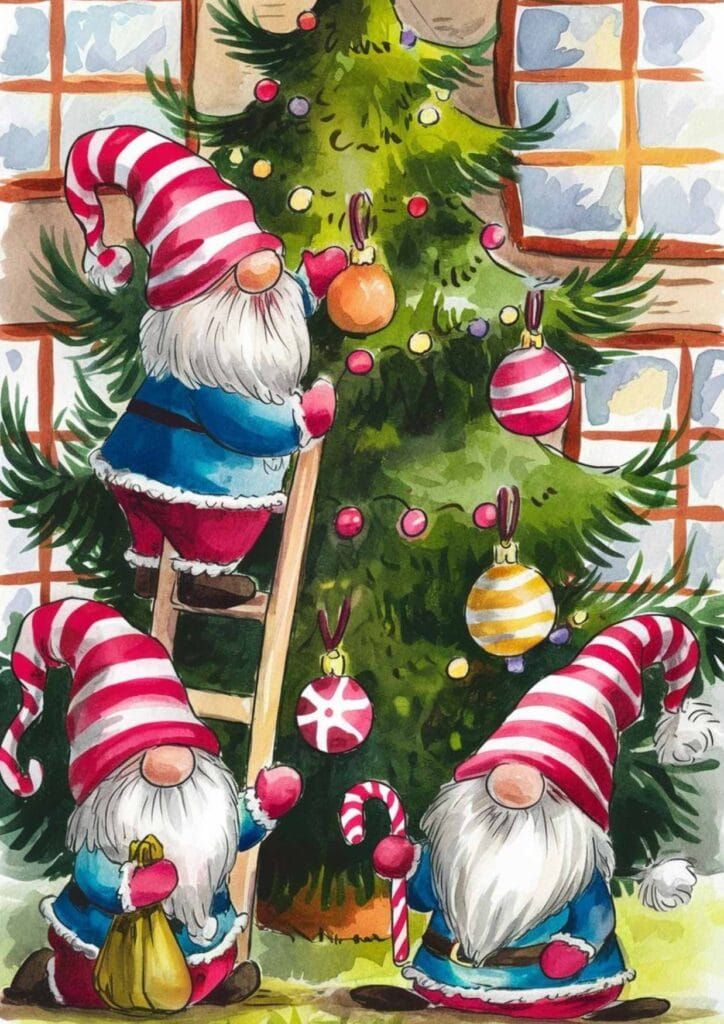

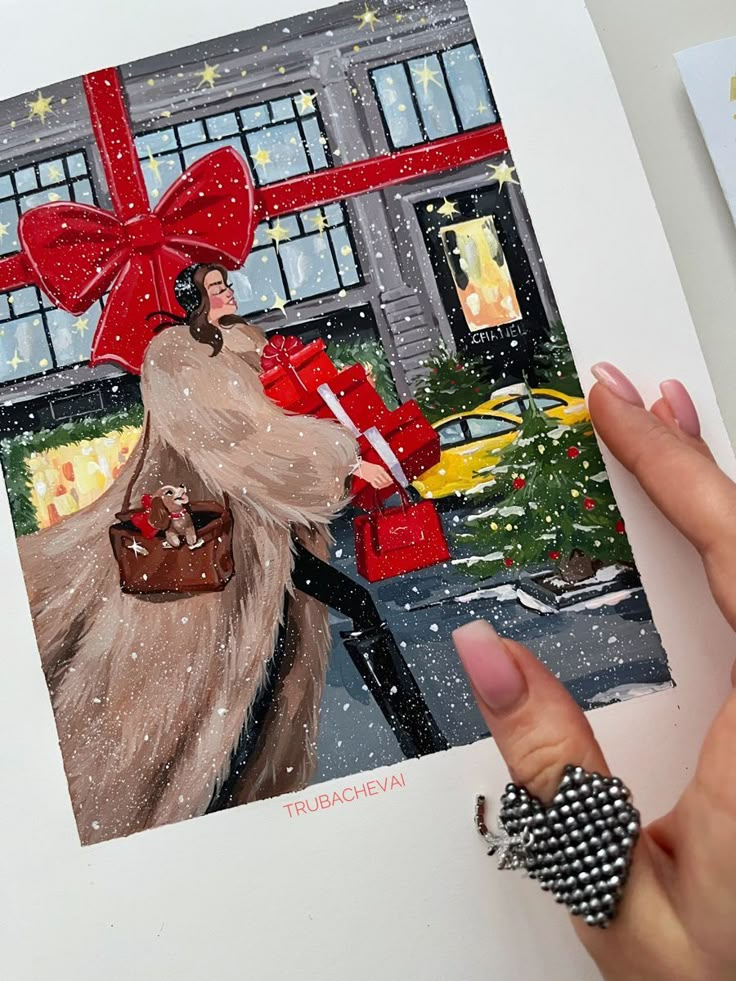
Mastering watercolor Christmas art requires understanding how to manipulate paint consistency, build dimensional color, and refine details that bring festive scenes to life.
Creating Unique Textures and Effects
You can achieve stunning textural effects by varying the water-to-paint ratio in your watercolors. A wet-on-wet technique creates soft, blended backgrounds perfect for snowy skies, while dry brushing adds rough texture to tree bark or evergreen branches.
Salt sprinkled onto wet watercolor paint creates snowflake-like crystals as it absorbs pigment. Try using different watercolor brushes to produce varied marks—round brushes for detailed ornaments, flat brushes for broad washes, and fine-tipped brushes for delicate pine needles.
Masking fluid preserves white areas for highlights on snow-covered rooftops or twinkling lights. Apply it before painting, let it dry completely, then remove it after your watercolor paint has dried to reveal crisp white spaces.
Layering Colors for Depth
Build dimension in your Christmas drawings by starting with light washes and gradually adding darker values. Your first layer should be translucent, establishing the overall color scheme of poinsettias, wreaths, or winter landscapes.
Wait for each layer to dry completely before adding the next to maintain clean color separation. Layer warm reds and greens for traditional holiday elements, allowing earlier washes to show through for natural depth.
You can create shadows by mixing complementary colors rather than adding black, which keeps your watercolors vibrant. Apply concentrated watercolor paint in the darkest areas while your previous layers remain lighter, establishing a clear focal point in your composition.
Adding Finishing Touches to Holiday Drawings
Fine details transform simple paintings into polished artwork. Use a small round brush with less water for controlled lines on ribbon bows, ornament hangers, or decorative patterns.
White gouache or gel pens add highlights that watercolor paint alone cannot achieve. Dot them onto ornaments, berries, or snowflakes for extra sparkle and dimension.
Consider adding metallic watercolors for gold stars or silver bells to enhance the festive quality. Your final touches should include checking value contrast—darkening shadows or lifting paint with a damp brush to lighten areas that need adjustment.
Creative Uses for Watercolor Christmas Drawings

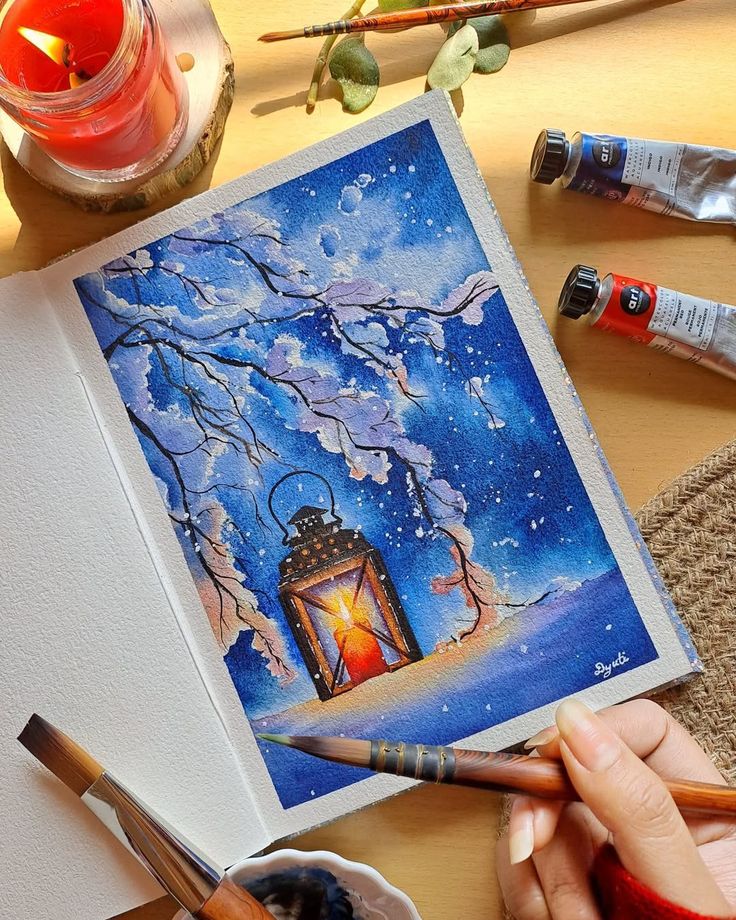
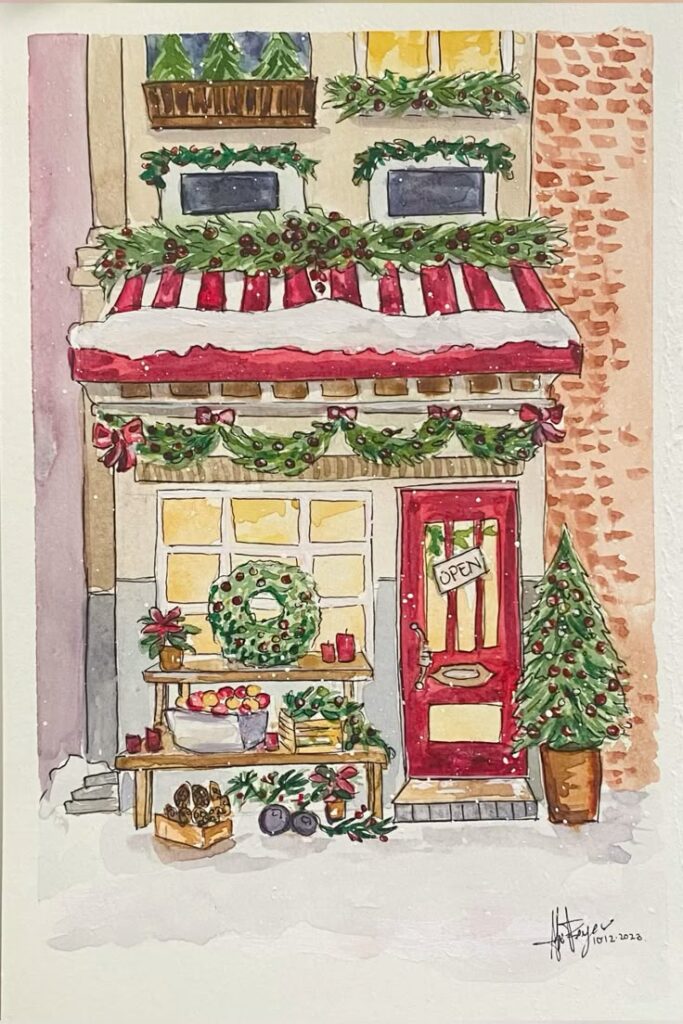
Watercolor Christmas drawings offer versatile applications beyond simple artwork, from personalized stationery to home décor and mindful activities. These hand-painted creations add warmth and character to holiday traditions while providing opportunities for creative expression.
Designing Holiday Cards and Gift Tags
Creating custom holiday cards with watercolor Christmas drawings adds a personal touch that store-bought options can’t match. You can paint simple motifs like Christmas trees, ornaments, wreaths, or snowflakes directly onto cardstock or create designs on watercolor paper that you attach to card bases.
Gift tags become miniature artworks when decorated with watercolor elements. Paint small festive images on thick watercolor paper, let them dry completely, then cut them into tag shapes and punch holes for ribbon or twine. These handmade tags elevate your gift presentation and show recipients you invested time and care.
You can also scan your finished watercolor paintings to create printables for multiple cards or tags. This approach lets you reproduce your favorite designs while maintaining the handmade aesthetic. Add personalized messages with calligraphy or simple handwriting to complete each piece.
Festive Decorations and Wall Art
Transform your watercolor Christmas drawings into seasonal décor by framing them as standalone pieces or creating gallery walls. Small paintings of winter scenes, holiday characters, or festive botanicals work beautifully in matching frames arranged together.
Your watercolor paintings can become garland decorations when strung together with twine or ribbon. Paint individual holiday images on small squares or circles of watercolor paper, allow them to dry, then attach them to create a unique banner for mantels or doorways.
Consider turning your artwork into ornaments by painting on round watercolor paper circles or wooden blanks sealed for watercolor use. These handpainted ornaments become treasured keepsakes that you can display year after year. You might also use your designs to decorate gift wrap, creating custom wrapping paper through printables or by painting directly onto kraft paper.
Watercolor Coloring Pages for Relaxation
Watercolor painting provides a meditative holiday activity that reduces stress during the busy season. Working with watercolors requires focus and patience, helping you slow down and enjoy the creative process without pressure for perfection.
You can find or create watercolor painting ideas specifically designed for beginners or those seeking relaxation. Simple subjects like single ornaments, candles, or holly branches offer manageable projects that deliver satisfying results in short sessions.
Printables featuring light pencil sketches of Christmas scenes give you starting points for watercolor practice. These templates remove the drawing challenge and let you focus entirely on color mixing, brush techniques, and layering washes. The repetitive motions of painting become a form of mindfulness that helps you unwind while producing beautiful seasonal artwork.
Free Printable Templates and Resources
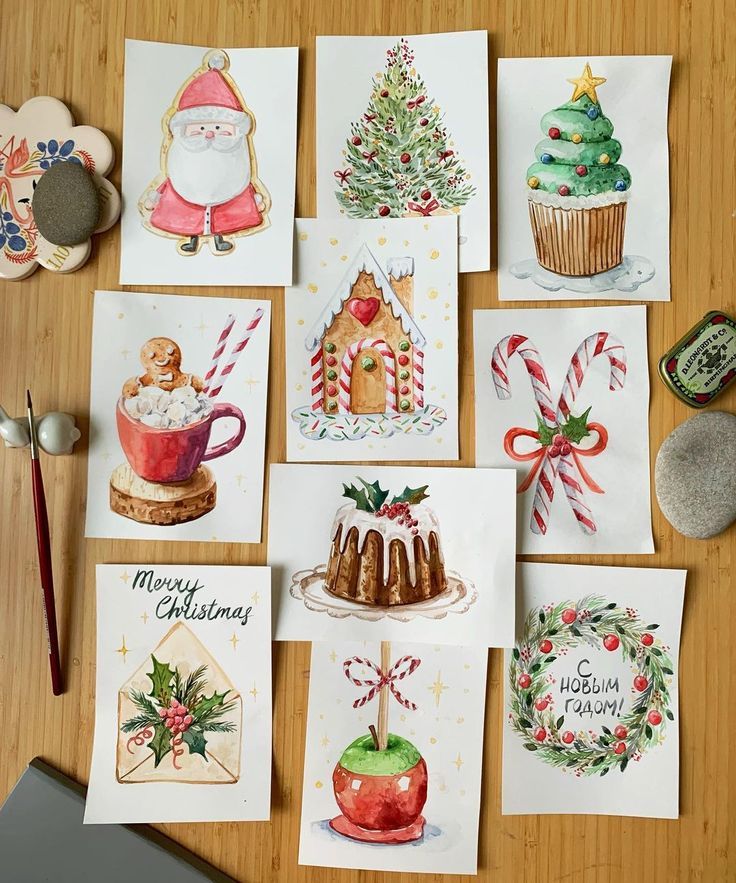

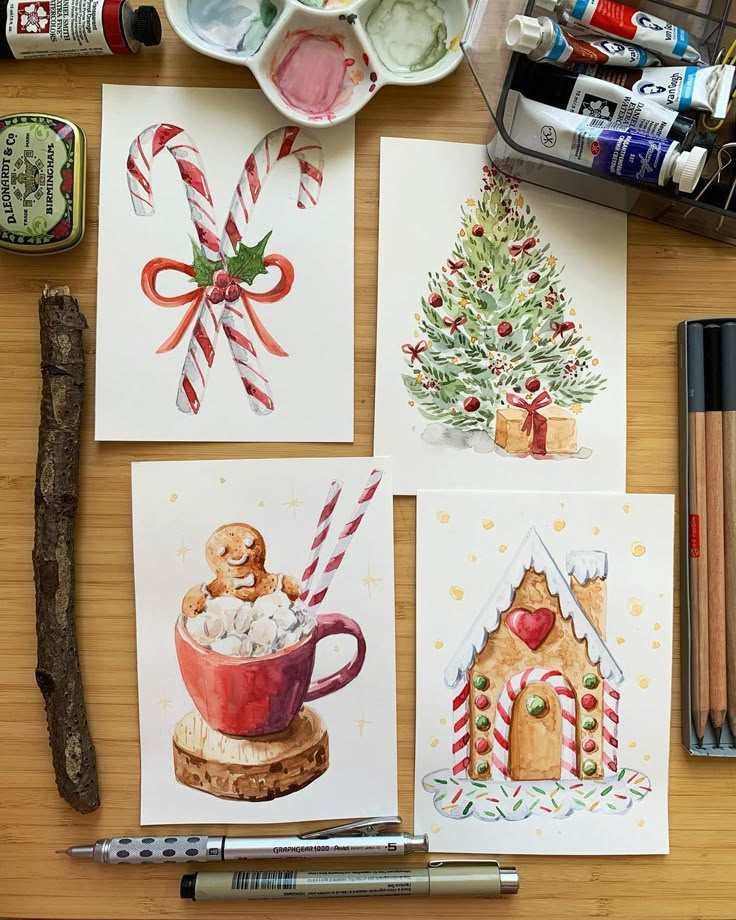
Free printable templates offer an accessible starting point for watercolor Christmas projects, while premium resources provide additional variety for more specific design needs.
Accessing Printable Watercolor Designs
You can find free printable templates on craft blogs, art education websites, and digital marketplaces that offer complimentary downloads. Many sites provide watercolor Christmas designs in multiple formats, including single cards, gift tags, and full-page prints suitable for framing.
When downloading free printable templates, check the file format and resolution. PDF files typically print best, while JPEG or PNG formats work well for digital projects. Most templates come sized for standard 8.5 x 11-inch paper, though some offer A4 options for international printing.
Look for collections that include multiple design variations from a single theme. Some resources provide 6 to 25 different watercolor scenes in one download, giving you options for cards, wall art, and gift embellishments without searching multiple sites.
Inspiration from Free and Premium Printables
Free printables showcase various watercolor styles, from soft pastel scenes to bold, vibrant illustrations. You’ll find designs featuring traditional motifs like holly, ornaments, winter landscapes, and festive typography.
Study how professional artists layer colors and leave white space in their designs. Many templates demonstrate techniques like color bleeding, gradient washes, and detail work that you can replicate in your own paintings. Premium collections often include commercial use rights and higher resolution files, making them suitable for small business applications or large-format printing.
Some templates work as coloring bases where you add your own watercolor details. Others serve as finished designs that you personalize with metallic accents, glitter, or handwritten messages.
How to Make the Most of Free Templates
Print templates on watercolor paper or cardstock instead of regular printer paper for better results. Watercolor paper handles paint without warping, while cardstock provides durability for cards and tags.
You can trace designs onto fresh watercolor paper if you want to add your own painted elements. Use a light box or sunny window to transfer outlines, then apply your color choices and painting style. This approach lets you practice specific techniques while maintaining professional composition.
Customize templates by combining elements from different designs. Cut out individual motifs and arrange them into unique compositions, or use digital editing software to adjust colors and add text before printing. Store your favorite templates in a dedicated folder so you can reprint designs for future holiday seasons.
- 0shares
- Facebook0
- Pinterest0
- Twitter0


